5G, eSIM Turn Cars Into Cellphones, WiFi Hotspots

Making and receiving phone calls, streaming content, downloading software updates and serving as WiFi hotspot for other devices will increasingly be done by cars — with no phone needed — with the speed and quality of 5G.
Those are some of the use cases highlighted by BMW and T-Mobile in announcing the embedded 5G support available on the new BMW iX and i4. T-Mobile’s Magenta Drive postpaid plan delivers 5G connectivity to these electric cars.
“Cars are transitioning from just a mode of transportation to an extension of home and work, and people on the go are depending on premium connectivity more than ever to power personalized in-car experiences and entertainment,” T-Mobile said in a press release announcing its service for these cars.
Adding Embedded 5G Connectivity
Along with BMW, several other automakers will also be rolling out vehicles that are equipped on the assembly line with the hardware needed to connect to 5G. Such plans have been announced by Verizon Business and Audi of America, LG and an unnamed European automaker, and AT&T and General Motors (GM).
Both Audi and GM said they expect to begin adding embedded 5G connectivity to select models in the United States in the 2024 model year.
Read more: More Vehicles Will Be Rolling off Assembly Lines With Embedded 5G
To enable connectivity on its two new cars, BMW will fit them with an embedded SIM (eSIM), which is a SIM card built into a mobile device such as a cellphone, tablet or smartwatch. In this case, the mobile device will be the car.
Delivering New Use Cases for Cars
This allows a customer to add their car to their existing mobile phone plan. T-Mobile noted that this means customers can make in-car calls using their personal cellphone number, even when their phone isn’t present. It also means customers will receive simultaneous incoming call notifications from the phone and the vehicle.
What’s more, connecting the car to the cellular network allows the customer to take advantage of the car’s 5G antenna to get a strong, more stable cellular signal and enable the use of an in-car WiFi hotspot — “providing users with high-speed internet access for mobile office work or video streaming in full HD quality,” BMW said in its own announcement.
Building a Market for Connected Services
The connectivity can also follow the driver to other compatible BMW vehicles — such as a car that is rented or shared — as the BMW Personal eSIM is linked to the user’s BMW ID. The users need only sign in with their BMW ID on the My BMW app, and then they can make and receive calls from the car using their own cellphone number.
Even if users do not sign up for the mobile phone plan, the vehicles will still use 5G to download remote software upgrades to the car in a fraction of the time it takes for earlier cars.
Together, these capabilities delivered by embedded 5G have makers of passenger cars, big rigs and powersports vehicles announcing plans to generate recurring revenue from their vehicles long after the sale. Using the vehicles’ connectivity, owners can keep their vehicles updated with the latest software as well as purchase additional vehicle capabilities and connected services.